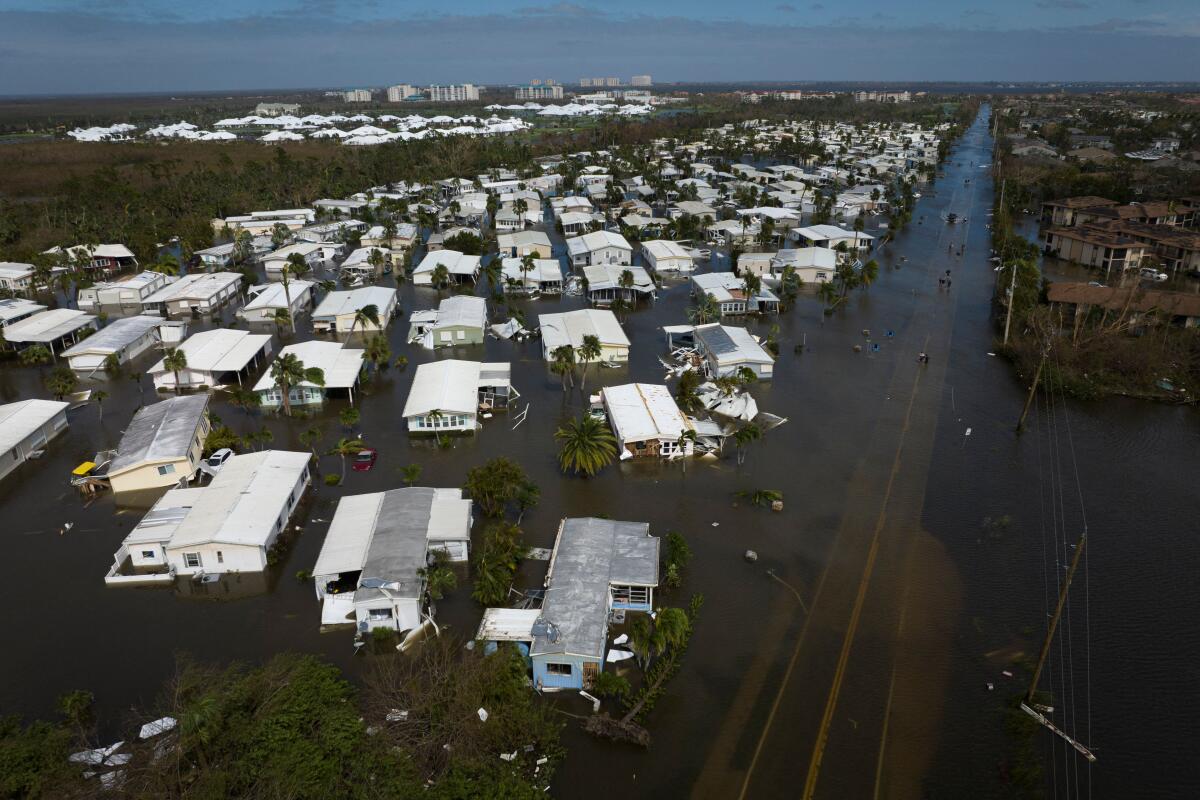Newsletter: I’m an alarmist on climate change, and you should be too

Good morning. I’m Paul Thornton, and it is Saturday, Oct. 8, 2022. Allow me to be the first half-Norwegian to wish you a happy Leif Erikson Day tomorrow. Let’s look back at the week in Opinion.
This week we published an op-ed piece that I wish could run every day — though maybe with a few updates to more fully explore its theme. That piece was Eugene Linden’s “ Hurricane Ian and the coming climate crash,” which focused on the economic disaster looming over South Florida in the wake of Hurricane Ian, as the insurance industry realizes it cannot cover all the claimed losses in an area hit repeatedly by intense storms and pulls out entirely from the market. So the crash, for Linden’s purposes, is economic.
But the term “climate crash” evokes so much more, and appropriately so. The unsustainability of offering home insurance policies in flood and fire zones gets at a particular pocketbook issue — a very important one, sure — but “climate crash” could also apply to long-term climactic instability upon us. For example, consider a new study by climate researchers at the World Weather Attribution Group, which showed that the once-every-400-years drought underway in the Northern Hemisphere can now be expected to occur every 20 years. This is the drought that dried up rivers in Europe and China (which, by the way, is experiencing another heat emergency) and continues to desiccate California and the rest of the western U.S. Once every 20 years isn’t a drought; it’s an aridification that renders our entire water delivery system obsolete and will soon force our retreat from exurban communities and mountain villages that will burn every 10 years instead of once every few generations.
I’d call that a “climate crash.”
Consider also the flooding (yes, we’ll still have that with higher temperatures and aridification). The short version is that it’ll get worse, when it does happen. The longer explanation is that scientists at UCLA this summer released a study showing that climate change is increasing the risk of a catastrophic megaflood striking California, similar to the sequence of mountain blizzards followed by warmer rains in 1862 that turned much of the Central Valley into an inland sea and inundated the Los Angeles basin. That was when California had about 400,000 people, or fewer than present-day Long Beach. We hadn’t yet reclaimed low-lying coastal areas for development, sucked enough groundwater from the Central Valley to cause land subsidence or built permanent settlements on the sides of mountains (which are already starting to wash away under current conditions).
That, also, I’d call a “climate crash.”
The fires too. Even the spread of diseases similar to COVID-19 and MPX. All are symptoms of a looming ecological and climactic collapse that can only be mitigated by ending our reliance on fossil fuels.
How have I come around to this dim view (some would call it “alarmism”)? I’ve largely set aside the commentary on climate change and focused on the increasingly pessimistic reports from the United Nations Intergovernmental Panel on Climate Change and the steady stream of bad news that scientists post on Twitter (a good list to follow can be found here; NASA’s Peter Kalmus has the most followers of any climate scientist I’ve seen on Twitter). If you read warnings from the experts rather than just their distillation in the media, you can’t help but come away with a sense of dread exceeded in intensity only by the need to do something drastic right now.
It might even turn you into a climate voter, because this country needs a lot more of them. Global warming and democracy’s decline merit top consideration by voters, but the crises are far from the top tier of concerns heading into the 2022 midterms, which are dominated by so-called pocketbook matters like inflation and gas prices. “I get it,” writes Nicholas Goldberg. “People have bills to pay and lives to live. But don’t be fooled. The big threats — especially to American democracy and to the fate of the planet — may seem abstract, but they matter more than ever.” L.A. Times
Restore the Salton Sea not to its former size but to its role in the ecosystem. Pumping desalinated ocean water from the Sea of Cortez into the dwindling desert lake is too costly and complex an undertaking. Instead, a desalination plant should be built right on the Salton Sea with the goal of reducing the lake’s salinity, allowing it to shrink to a sustainable (but still very large) size that serves migratory birds and maintains a crucial food web, write Brent M. Haddad and Robert Glennon. L.A. Times
Don’t blame the sharks, they just swim (and eat) here. Warmer waters moving up California’s coastline have attracted juvenile white sharks (commonly known as great white sharks) to areas previously free of them. Some are hanging around a newly warm pocket in the Monterey Bay, threatening the sea otter population that had been brought back by years of conservation work. Don’t get mad at the sharks, writes Aimee David: “Of course, sharks are not the problem; the greenhouse gases that make the ocean warmer, more acidic and less oxygen rich are to blame. These climate change impacts are altering the fundamental structure of the ocean’s chemical, physical and ecological systems, with devastating consequences to ocean life and the health of our planet.” L.A. Times
Enjoying this newsletter? Consider subscribing to the Los Angeles Times
Your support helps us deliver the news that matters most. Become a subscriber.
Here is a partial list of The Times Editorial Board’s endorsements for the Nov. 8 election; more will be posted as they are published. Visit latimes.com/endorsements for updates.
Proposition 1: Yes
Propositions 26 and 27: No
Proposition 28: Yes
Proposition 29: No
Proposition 30: No
Proposition 31: Yes
L.A. city attorney: Hydee Feldstein Soto
L.A. City Council District 5: Katy Young Yaroslavsky
L.A. City Council District 11: Erin Darling
L.A. City Council District 15: Danielle Sandoval
Proposition LH (city of Los Angeles): Yes
Proposition SP (city of Los Angeles): No
Proposition ULA (city of Los Angeles): Yes
Los Angeles County sheriff: Robert Luna
L.A. County Measure A: Yes
L.A. County Board of Supervisors, District 3: Lindsey Horvath
LAUSD Board District 2: María Brenes
LAUSD Board District 6: Kelly Gonez
Lieutenant governor: Eleni Kounalakis
Secretary of state: Shirley Weber
State attorney general: Rob Bonta
State controller: Lanhee Chen
State treasurer: Fiona Ma
State insurance commissioner: Ricardo Lara
State superintendent of public instruction: Tony Thurmond
State Senate District 20: Caroline Menjivar
State Senate District 28: Lola Smallwood-Cuevas
State Assembly District 39: Juan Carrillo
State Assembly District 51: Rick Chavez Zbur
State Assembly District 61: Tina McKinnor
State Assembly District 69: Josh Lowenthal
U.S. Senate: Alex Padilla
U.S. Congressional District 27: Christy Smith
U.S. Congressional District 37: Sydney Kamlager
U.S. Congressional District 40: Asif Mahmood
U.S. Congressional District 41: Will Rollins
U.S. Congressional District 42: Robert Garcia
U.S. Congressional District 45: Jay Chen
U.S. Congressional District 47: Katie Porter
Stay in touch.
If you’ve made it this far, you’re the kind of reader who’d benefit from subscribing to our other newsletters and to The Times.
As always, you can share your feedback by emailing me at [email protected].
A cure for the common opinion
Get thought-provoking perspectives with our weekly newsletter.
You may occasionally receive promotional content from the Los Angeles Times.




